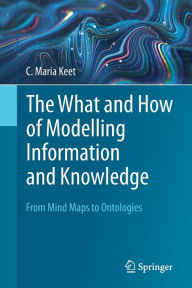The What and How of Modelling Information and Knowledge: From Mind Maps to Ontologies. C. Maria Keet

The-What-and-How-of.pdf
ISBN: 9783031396946 | 177 pages | 5 Mb

- The What and How of Modelling Information and Knowledge: From Mind Maps to Ontologies
- C. Maria Keet
- Page: 177
- Format: pdf, ePub, fb2, mobi
- ISBN: 9783031396946
- Publisher: Springer Nature Switzerland
Download new free books The What and How of Modelling Information and Knowledge: From Mind Maps to Ontologies
The main aim of this book is to introduce a group of models and modelling of information and knowledge comprehensibly. Such models and the processes for how to create them help to improve the skills to analyse and structure thoughts and ideas, to become more precise, to gain a deeper understanding of the matter being modelled, and to assist with specific tasks where modelling helps, such as reading comprehension and summarisation of text. The book draws ideas and transferrable approaches from the plethora of types of models and the methods, techniques, tools, procedures, and methodologies to create them in computer science. This book covers five principal declarative modelling approaches to model information and knowledge for different, yet related, purposes. It starts with entry-level mind mapping, to proceed to biological models and diagrams, onward to conceptual data models in software development, and from there to ontologies in artificial intelligence and all the way to ontology in philosophy. Each successive chapter about a type of model solves limitations of the preceding one and turns up the analytical skills a notch. These what-and-how for each type of model is followed by an integrative chapter that ties them together, comparing their strengths and key characteristics, ethics in modelling, and how to design a modelling language. In so doing, we’ll address key questions such as: what type of models are there? How do you build one? What can you do with a model? Which type of model is best for what purpose? Why do all that modelling? The intended audience for this book is professionals, students, and academics in disciplines where systematic information modelling and knowledge representation is much less common than in computing, such as in commerce, biology, law, and humanities. And if a computer science student or a software developer needs a quick refresher on conceptual data models or a short solid overview of ontologies, then this book will serve them well.
Using a typed mind map as data model in a TDD DICE
Typed mind maps and a semantic node are defined by OWL-DL. Typed mind maps are now widely used in the DICE system as a uniform data model for the system,
(PDF) Semantics of Knowledge Map Visualization
A mind map represents the data as a drawing that shows the link between different elements of information and can assist in theory-refining for an
An Introduction to Ontologies and Ontology Engineering
In this example the information ontology does not look like a Mind Map but it communication between agents (human or software) or reusing data model or.
Screenshot of a free mind mapping software called
Ontologies can be used to assign semantics to information items and solve interoperability and knowledge-related problems. Many methods have been proposed to
From Mind Maps to Ontologies (Paperback)
The What and How of Modelling Information and Knowledge: From Mind Maps to Ontologies (Paperback) Her research focuses on ontology engineering, conceptual
The use of concept maps during knowledge elicitation in
Incorporation of ontologies into annotations has enabled 'semantic integration' of complex data, making explicit the knowledge within a certain
Other ebooks:
PDF [Download] The Love Hypothesis by
SÍ IMPORTA EL MODO EN QUE UN HOMBRE SE HUNDE leer el libro
0コメント